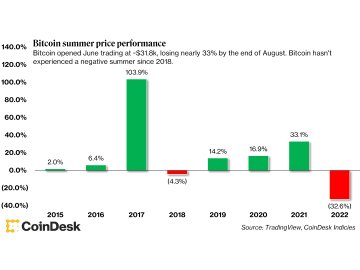
Will an uncharacteristically weak summer lead to even more pain for bitcoin’s price in September, a month when it typically drops?
It’s Labor Day weekend, which means that summer is over. No, I do not care that the autumn season hasn’t officially started; summer is over when August is over.
Anyway, the finance world is usually slow in August since that’s when Wall Street’s finest unwind by doing work by the dim light of their mobile phones in the Hamptons instead of by the bright light of their offices in the Financial District. Now bitcoin, not to be upstaged, thought it would be best to buck that trend entirely by effectively erasing all of July’s price gains in August.
So let’s talk about summer markets.
First, let’s let summer mean from the start of June to the end of August. If you look at bitcoin’s last two monthly candles, they look like mirror images of each other, with July’s green and August’s red (see below).
Candles show how the price of an asset changed over a specified time period. The end of the lines (or wicks) on either side of the rectangles touch the low and high price during the time period, and the bottoms and tops of the rectangles (or candlesticks) represent the open and close price during that time period. Green candles mean the price went up; red candles mean the price went down.
In this case: bitcoin started July around $19.9K, hit a monthly low of about $18.8K, peaked around $24.7K in July, and ended July around $23.3K. It then started August around $23.3K, sank to $19.6K, climbed as high as $25.2K, and ended the month around $20.0K.
So you could say that bitcoin has taken the summer off – except June happened. Bitcoin opened June trading at about $31.8K, which means bitcoin’s price fell about 33% in the summer. To test the idea that “nothing happens in finance in the summer,” you could compare bitcoin’s summer to the S&P 500’s, which has lost about 4.3% since June (maybe things do happen in finance in the summer).
